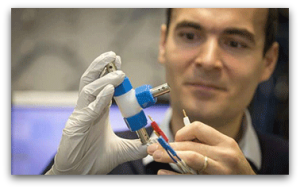 The Solabat project gives new meaning to the term solar + storage – it aims to combine the two on a single device.
The Solabat project gives new meaning to the term solar + storage – it aims to combine the two on a single device.
Researchers at the Graz University of Technology (TU Graz) say they are entering largely unknown scientific territory with the project.
While small solar + battery devices are already widely available, the Solabat project is thinking much tighter integration and potentially much bigger – up to full size solar panels such as those used in home solar power installations.
“Currently single systems of photovoltaic cells which are connected together – mostly lead-based batteries and vast amounts of cable – are in use. Solar panels on the roof with a battery in the cellar. This takes up a lot of space, needs frequent maintenance and is not optimally efficient,” says Dr. Ilie Hanzu from TU Graz’s Institute of Chemistry and Technology of Materials.
While the new generation of home energy storage systems, including the Fronius Solar Battery, Tesla Powerwall and the Enphase AC Battery are lithium-ion based, are a single unit and require little in the way of maintenance; a solar panel battery hybrid could save on space and offer a level of redundancy.
Dr. Hanzu says the tighter integration of solar and storage means materials need to be closely scrutinized.
” We need materials which reliably fulfil their respective tasks and which are also electrochemically compatible with other materials so that they work together in one device.”
Among the materials, the Solabat team is looking at the possibility of using eco-friendly titanates for electrodes and organic solar cells.
“We have to know what happens when the materials come into contact with each other. For this reason, our project partner, the Centre for Electron Microscopy, is investigating the underlying fundamental interface effects and reactions.”
Dr. Hanzu is confident that at the end of SolaBat project, the team will be able to present a working concept of a photovoltaic battery hybrid.
This won’t be the first time the potential for a solar + battery hybrid has been investigated. In 2013, we reported on research that could see solar panels also incorporating battery functions by using the same material that creates the electricity – silicon. To read more click here.




